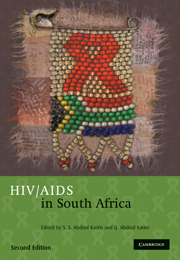Book contents
- Frontmatter
- Contents
- List of Contributors
- Foreword: Peter Piot
- Foreword: Nelson R Mandela
- Acknowledgements
- Section 1 Birth of a rapidly growing epidemic
- 1 Introduction
- 2 Overview of the book
- 3 HIV infection in South Africa: the evolving epidemic
- 4 HIV incidence rates in South Africa
- Section 2 The virus, the human host and their interactions
- Section 3 HIV risk factors and prevention strategiess
- Section 4 Focal groups for understanding the HIV epidemic
- Section 5 The impact of AIDS
- Section 6 Treating HIV
- Section 7 What does the future hold?
- Index
3 - HIV infection in South Africa: the evolving epidemic
Published online by Cambridge University Press: 07 September 2011
- Frontmatter
- Contents
- List of Contributors
- Foreword: Peter Piot
- Foreword: Nelson R Mandela
- Acknowledgements
- Section 1 Birth of a rapidly growing epidemic
- 1 Introduction
- 2 Overview of the book
- 3 HIV infection in South Africa: the evolving epidemic
- 4 HIV incidence rates in South Africa
- Section 2 The virus, the human host and their interactions
- Section 3 HIV risk factors and prevention strategiess
- Section 4 Focal groups for understanding the HIV epidemic
- Section 5 The impact of AIDS
- Section 6 Treating HIV
- Section 7 What does the future hold?
- Index
Summary
CROSS-SECTIONAL DATA ON HIV prevalence in South Africa is widely available, the most extensive being based on the annual surveillance set up by the National Department of Health in 1990 to monitor the prevalence of HIV infection in women attending public antenatal clinics. Many additional surveys, including three national population-based surveys, have since been conducted in South Africa, providing crucial information on epidemic trends, patterns of infection and factors that contribute to the spread of the epidemic.
South Africa experienced one of the fastest growing hiv epidemics in the world and is currently the country with the largest number of people living with hiv, contributing to about 17% of the global burden of hiv infection. The epidemic, predominantly of subtype C, is characterised by high hiv prevalence and high rates of new infections among young women. The prevalence varies by age, gender and geographic area. Data collected over recent years indicate that the epidemic is levelling off, an effect that is unlikely to be due to interventions, but simply reflects the natural saturation of the epidemic.
This chapter provides a summary of the hiv epidemic in time and space and gives an introduction to factors that influence the transmission of hiv. Our understanding of the hiv epidemic in South Africa depends largely on a range of sero-prevalence surveys that have been conducted in a variety of settings and populations; a brief description of some of these sources of hiv data is provided.
- Type
- Chapter
- Information
- HIV/AIDS in South Africa , pp. 55 - 73Publisher: Cambridge University PressPrint publication year: 2010
- 3
- Cited by



